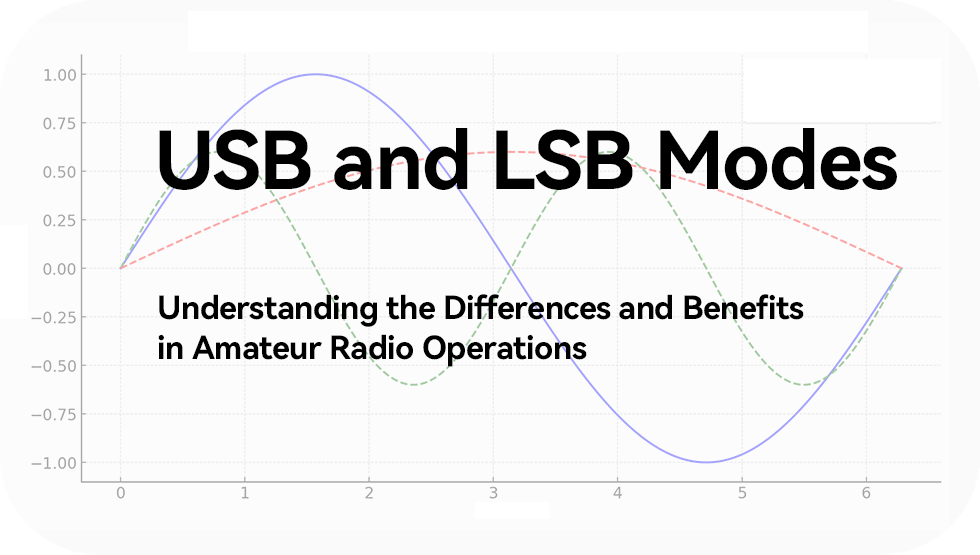Introduction
In the world of amateur radio, communication can occur across various frequencies, but modes like USB (Upper Sideband) and LSB (Lower Sideband) are among the most efficient for clear and effective transmissions. These modes are widely used in modern communication, especially in HF (High Frequency) bands like 10 meters. In this blog, we will explore the differences between USB and LSB, their unique advantages, and how to make the most of these modes in amateur radio operations.
1. What Are USB and LSB Modes?
-
Definition of USB (Upper Sideband) USB, or Upper Sideband, is a modulation mode where the carrier signal is suppressed, and only the upper sideband portion of the signal is transmitted. It is commonly used in higher frequency bands, such as 20 meters and above. USB’s characteristics make it ideal for long-distance communication, especially during times of peak solar activity.
-
Definition of LSB (Lower Sideband) LSB, or Lower Sideband, works similarly to USB but transmits the lower sideband of the signal. LSB is typically used in lower-frequency bands, such as 80 meters, 40 meters, and 160 meters. It follows the same principle as USB by suppressing the carrier and transmitting only the sideband portion.
2. Differences Between USB and LSB
-
Frequency Range
-
USB is predominantly used for frequencies above 10 MHz, especially on 15 meters, 20 meters, and 10 meters bands. These higher frequency bands make USB the preferred mode for communication in these areas.
-
LSB is typically used for frequencies below 10 MHz, like the 160 meters, 80 meters, and 40 meters bands. These lower frequency bands are more suited to LSB mode for clear transmission.
-
-
Common Uses
-
USB is commonly used for long-distance communication (DXing), especially in HF bands. It is the preferred mode for international contacts, especially when solar activity enhances signal propagation.
-
LSB is often used for local communication and short-range operations, especially in the lower HF bands.
-
3. Why Are USB and LSB Modes Crucial for Communication?
-
Bandwidth Efficiency Both USB and LSB offer greater bandwidth efficiency compared to traditional AM (Amplitude Modulation). By using sideband modulation, these modes allow for more channels to coexist within the same frequency range, reducing interference and increasing spectral efficiency.
-
Signal Clarity By focusing on the sidebands, both USB and LSB offer superior clarity compared to AM modulation. This makes them ideal for weak signal communication or long-distance contacts where noise can otherwise degrade signal quality.
4. USB and LSB in the 10 Meter Band
-
Why USB is More Common Above 10 MHz? The 10-meter band is situated above 28 MHz, which is why USB is the dominant mode in this range. The solar cycle and solar activity significantly impact signal propagation in the 10-meter band, making it a prime choice for DXing (long-distance communication). USB’s bandwidth efficiency and ability to operate effectively during peak solar activity make it ideal for the 10-meter band.
-
Why LSB is More Common Below 10 MHz? On the other hand, the lower HF bands, such as 80 meters and 40 meters, use LSB because of historical conventions and better signal propagation characteristics in those bands.
5. Practical Applications of USB and LSB in Amateur Radio
-
Long-Distance Communication (DXing)
-
USB is highly effective for DXing in higher HF bands like the 10-meter band. During times of heightened solar activity, the 10-meter band offers exceptional long-range propagation, and USB provides the clear, efficient signal necessary for successful communication.
-
-
Emergency Communication
-
Both USB and LSB play critical roles in emergency communication. In times of crisis, when reliable communication is paramount, these modes ensure clear, uninterrupted contact. LSB is often preferred for local communications, while USB excels for long-range emergency broadcasts.
-
-
Casual Communication and Contests
-
For casual communication and radio contests, USB and LSB offer flexibility. Operators can choose the best mode based on the frequency band they are working in, ensuring clear, efficient communication without unnecessary interference.
-
6. Tips for Using USB and LSB
-
Optimal Performance Settings
-
When using either USB or LSB, it’s essential to fine-tune your settings for optimal performance. Adjusting filters, squelch, and noise reduction can help minimize interference and improve clarity during transmission.
-
-
Antenna Setup for USB and LSB
-
Choosing the right antenna is crucial for effective communication in both USB and LSB modes. Whether operating on the 10-meter band using USB or lower frequencies using LSB, ensure your antenna is properly tuned for the band and mode you are using to achieve maximum signal strength.
-
7. Common Mistakes to Avoid When Using USB and LSB
-
Incorrect Mode Selection
-
One of the most common mistakes is using the wrong mode for the frequency range. Remember, USB is used for frequencies above 10 MHz (like the 10-meter band), while LSB is used for frequencies below 10 MHz. Always ensure you are using the correct mode for the frequency you are operating on.
-
-
Overdriving the Signal
-
Overdriving the transmitter can lead to distortion and poor signal quality. Make sure to adjust your power output and modulation settings to avoid overdriving, ensuring that the signal is clear and not causing interference to others.
-
8. Conclusion
In conclusion, USB and LSB are essential modes in amateur radio, each serving specific frequency ranges and communication needs. Whether you are working in the 10-meter band with USB for long-distance communications or using LSB for local contacts on lower HF bands, both modes offer distinct advantages for clear, efficient communication.
By understanding how these modes operate and knowing when to use them, amateur radio operators can maximize their communication potential. Whether you're involved in DXing, emergency communication, or just casual conversations, USB and LSB are invaluable tools for achieving optimal communication performance.












